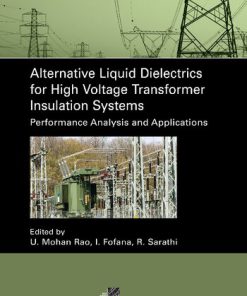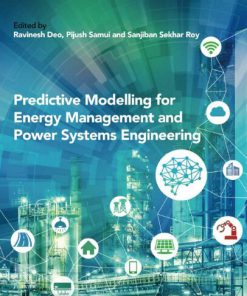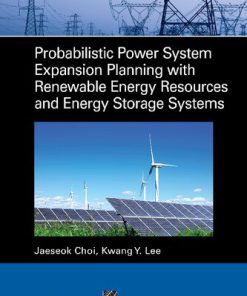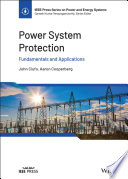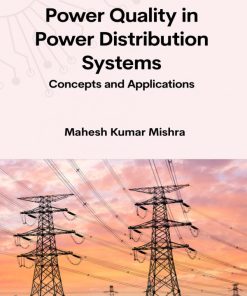Intelligent Data Mining and Analysis in Power and Energy Systems 1st Edition by Zita Vale, Tiago Pinto, Michael Negnevitsky, Ganesh Kumar Venayagamoorthy ISBN 9781119834045 111983404X
$50.00 Original price was: $50.00.$25.00Current price is: $25.00.
Intelligent Data Mining and Analysis in Power and Energy Systems 1st Edition by Zita Vale, Tiago Pinto, Michael Negnevitsky, Ganesh Kumar Venayagamoorthy – Ebook PDF Instant Download/Delivery: 9781119834045 ,111983404X
Full download Intelligent Data Mining and Analysis in Power and Energy Systems 1st Edition after payment
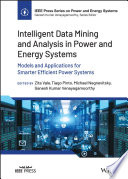
Product details:
ISBN 10: 111983404X
ISBN 13: 9781119834045
Author: Zita Vale, Tiago Pinto, Michael Negnevitsky, Ganesh Kumar Venayagamoorthy
Intelligent Data Mining and Analysis in Power and Energy Systems
A hands-on and current review of data mining and analysis and their applications to power and energy systems
In Intelligent Data Mining and Analysis in Power and Energy Systems: Models and Applications for Smarter Efficient Power Systems, the editors assemble a team of distinguished engineers to deliver a practical and incisive review of cutting-edge information on data mining and intelligent data analysis models as they relate to power and energy systems. You’ll find accessible descriptions of state-of-the-art advances in intelligent data mining and analysis and see how they drive innovation and evolution in the development of new technologies.
The book combines perspectives from authors distributed around the world with expertise gained in academia and industry. It facilitates review work and identification of critical points in the research and offers insightful commentary on likely future developments in the field. It also provides:
- A thorough introduction to data mining and analysis, including the foundations of data preparation and a review of various analysis models and methods
- In-depth explorations of clustering, classification, and forecasting
- Intensive discussions of machine learning applications in power and energy systems
Perfect for power and energy systems designers, planners, operators, and consultants, Intelligent Data Mining and Analysis in Power and Energy Systems will also earn a place in the libraries of software developers, researchers, and students with an interest in data mining and analysis problems.
Intelligent Data Mining and Analysis in Power and Energy Systems 1st Edition Table of contents:
Part I: Data Mining and Analysis Fundamentals
1 Foundations
1.1 Data Mining: Why and What?
1.2 Data Mining into KDD
1.3 The Data Mining Process
1.4 Data Mining Task and Techniques
1.5 Data Mining Issues and Considerations
1.6 Summary
References
2 Data Mining and Analysis in Power and Energy Systems: An Introduction to Algorithms and Applications*
Acronyms
2.1 Introduction
2.2 Data Mining Technologies
2.3 Data Mining Applications in Power Systems
2.4 Discussion and Final Remarks
References
Note
3 Deep Learning in Intelligent Power and Energy Systems
3.1 Introduction
3.2 Deep Learning
3.3 Accomplishments, Limitations, and Challenges
3.4 Conclusions
References
Part II: Clustering
4 Data Mining Techniques Applied to Power Systems
4.1 Introduction
4.2 Data Mining Techniques
4.3 Data Mining Techniques Applied to Power Systems
4.4 Electrical Tariffs Design Based on Data Mining Techniques
4.5 Data Mining Contributions to Characterize Zonal Prices
4.6 Data Mining‐Based Methodology for Wind Forecasting
4.7 Final Remarks
References
5 Synchrophasor Data Analytics for Anomaly and Event Detection, Classification, and Localization
5.1 Introduction
5.2 Synchrophasor Data Quality Issues and Challenges
5.3 ML‐Based Anomaly Detection, Classification, and Localization (ADCL) Over Data Drifting Multivariate Synchrophasor Data Streams
5.4 Synchrophasor Data Anomaly and Event Detection, Localization, and Classification (SyncAED)
5.5 Test‐Bed and Test Cases
5.6 Results and Discussion
5.7 Summary
Acknowledgments
References
6 Clustering Methods for the Profiling of Electricity Consumers Owning Energy Storage System
6.1 Introduction
6.2 Methodology Definition
6.3 Clustering of Consumers with ESS
6.4 Conclusion
Acknowledgments
References
Part III: Classification
7 A Novel Framework for NTL Detection in Electric Distribution Systems
7.1 Introduction
7.2 Data Acquisition and Pre‐Processing
7.3 Feature Extraction
7.4 Classification Strategies
7.5 Evaluation
7.6 Experiments
7.7 Conclusion
References
8 Electricity Market Participation Profiles Classification for Decision Support in Market Negotiation
8.1 Introduction
8.2 Bilateral Negotiation
8.3 Decision Support for Bilateral Negotiations
8.4 Illustrative Results
8.5 Conclusion
References
9 Socio‐demographic, Economic, and Behavioral Analysis of Electric Vehicles
9.1 Introduction
9.2 Electric Vehicle Outlook
9.3 Data Mining Models for EVs
9.4 Conclusions
References
Part IV: Forecasting
10 A Multivariate Stochastic Spatiotemporal Wind Power Scenario Forecasting Model
10.1 Introduction
10.2 Generalized Dynamic Factor Model
10.3 Conclusion
References
11 Spatiotemporal Solar Irradiance and Temperature Data Predictive Estimation
11.1 Introduction
11.2 Virtual Weather Stations
11.3 Distributed Weather Forecasting
11.4 Results and Discussion
11.5 Summary
Acknowledgment
References
12 Application of Decomposition‐Based Hybrid Wind Power Forecasting in Isolated Power Systems with High Renewable Energy Penetration
12.1 Introduction
12.2 Decomposition Techniques
12.3 Decomposition‐Based Neural Network Forecasting
12.4 Forecast‐Based Dispatch in Isolated Power Systems
12.5 Case Studies
12.6 Conclusions and Discussions
References
Part V: Data Analysis
13 Harmonic Dynamic Response Study of Overhead Transmission Lines
13.1 Introduction to Methodology
13.2 Problem Formulation
13.3 Numerical Analysis
13.4 Conclusion
13.A Appendix
References
14 Evaluation of Shortest Path to Optimize Distribution Network Cost and Power Losses in Hilly Areas: A Case Study
14.1 Introduction
14.2 Design of Power Distribution Network
14.3 Digital Elevation Map
14.4 Placement of Generators and Load Centers
14.5 Single Line Diagram of 9‐Bus System
14.6 Finding Shortest Path Between Load/Generating Centers
14.7 Selection of Conductor Using Newton Raphson Method
14.8 Calculation of CO2 Emission Cost Saving
14.9 Overall Cost Estimation of Distribution System
14.10 Sensitivity Analysis
14.11 Conclusion
References
15 Intelligent Approaches to Support Demand Response in Microgrid Planning
15.1 Introduction
15.2 Microgrid Planning
15.3 Demand Response in Microgrids
15.4 Intelligent Approaches to Support Demand Response
15.5 Conclusion
References
16 Socioeconomic Analysis of Renewable Energy Interventions: Developing Affordable Small‐scale Household Sustainable Technologies in Northern Uganda
16.1 Introduction
16.2 Renewable Energy Technologies
16.3 Methodology
16.4 Application of the Method
16.5 Case Study Results for Product Development
16.6 Cost–Benefit Analysis (CBA)
16.7 Conclusion
References
Note
Part VI: Other Machine Learning Applications
17 Non‐Intrusive Load Monitoring Using A Parallel Bidirectional Long Short‐Term Memory Model
17.1 Introduction
17.2 NILM System and Data Preprocessing
17.3 Proposed Method
17.4 Validation
17.5 Conclusion
References
Note
18 Reinforcement Learning for Intelligent Building Energy Management System Control*
Chapter Objectives
18.1 Introduction
18.2 Reinforcement Learning
18.3 Applications of Deep Reinforcement Learning in Building Energy Management Systems Control
18.4 Challenges and Research Directions
18.5 Conclusions
References
Note
19 Federated Deep Learning Technique for Power and Energy Systems Data Analysis
Nomenclature
19.1 Introduction
19.2 Federated Learning (FL)
19.3 Power Systems Challenges and the Performance of Artificial Intelligence Techniques in It
19.4 Application of Federated Deep Learning in Power and Energy Systems
19.5 Conclusion
References
20 Data Mining and Machine Learning for Power System Monitoring, Understanding, and Impact Evaluation
20.1 Introduction
20.2 Power System Monitoring with Phasor Measurement Unit Data
20.3 Power System Mechanistic and Predictive Understanding
20.4 Characterization and Modelling of Weather and Power Extremes
20.5 Conclusion
References
Conclusions
Index
People also search for Intelligent Data Mining and Analysis in Power and Energy Systems 1st Edition:
Tags: Zita Vale, Tiago Pinto, Michael Negnevitsky, Ganesh Kumar Venayagamoorthy, Intelligent Data Mining, Energy Systems
You may also like…
Engineering - Electrical & Electronic Engineering
Mathematics - Applied Mathematics
Predictive Modelling for Energy Management and Power Systems Engineering 1st Edition Ravinesh C. Deo
Uncategorized
Power Quality in Power Systems, Electrical Machines, and Power-Electronic Drives 3rd Edition Fuchs
Engineering - Electrical & Electronic Engineering
Engineering - Energy & Power Resources
Intelligent Data Analytics for Power and Energy Systems 1st Edition Hasmat Malik
Engineering - Energy & Power Resources
Engineering - Energy & Power Resources
Electrical Power and Energy Systems for Transportation Applications Paul Stewart Chris Bingham
Computers - Programming
Data Analytics Models and Algorithms for Intelligent Data Analysis 2nd Edition Thomas A Runkler



